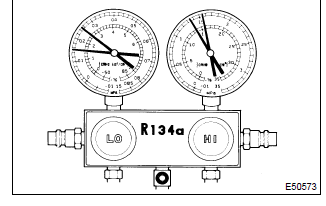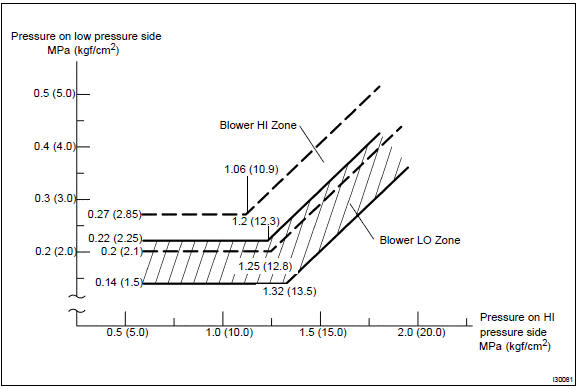Toyota Corolla (E120) 2002–2008 Repair Manual / Heater & air conditioner / Refrigerant / On–vehicle inspection
Toyota Corolla (E120): On–vehicle inspection
1. Inspect refrigerant pressure with manifold gauge set
- this is a method in witch the trouble is located by using
a manifold gauge set. Read the manifold gauge pressure
when the these conditions are established.
Test conditions:
- temperature at the air inlet with the switch set at recirc is 30 – 35 °c (86 – 95 °f)
- engine running at 1500 rpm
- blower speed control switch at ”hi” position
- temperature control dial at ”cool” position a/c switch on
- fully open doors

- Normally functioning refrigeration system.
Gauge reading:
low pressure side:
0.15 – 0.25 Mpa (1.5 – 2.5 Kgf/cm2) high pressure side:
1.37 – 1.57 Mpa (14 – 16 kgf/cm2)
- Moisture present in refrigeration system.

|
Symptom |
Probable cause |
Diagnosis |
Remedy |
| During operation, pressure on low pressure side sometimes become a vacuum and sometime normal | Moisture in refrigerating system freezes at expansion valve orifice causing a temporary stop of cycle, however, when it melts, normal state is restored. |
|
|
- Insufficient cooling

|
Symptom |
Probable cause |
Diagnosis |
Corrective actions |
|
Gas leakage in refrigeration system |
|
|
- Poor circulation of refrigerant

|
Symptom |
Probable cause |
Diagnosis |
Corrective actions |
|
Refrigerant flow obstructed by dirt in receiver | Receiver clogged | Replace condenser |
- Refrigerant does not circulate

|
Symptom |
Probable cause |
Diagnosis |
Corrective actions |
|
|
Refrigerant does not circulate |
|
- Refrigerant overcharged or insufficient cooling of condenser

|
Symptom |
Probable cause |
Diagnosis |
Corrective actions |
|
|
|
|
- Air present in refrigeration system

|
Symptom |
Probable cause |
Diagnosis |
Corrective actions |
|
Air entered in refrigerating system |
|
|
- Expansion valve improperly

|
Symptom |
Probable cause |
Diagnosis |
Corrective actions |
|
Trouble in expansion valve |
|
Check expansion valve |
- Defective compression compressor

|
Symptom |
Probable cause |
Diagnosis |
Corrective actions |
|
Internal leak in compressor |
|
Repair or replace compressor |
Gauge readings (reference)

Other materials:
Wiper rubber lh
Replacement
1. Remove fr wiper blade lh
remove the front wiper blade lh from the front wiper arm lh.
Notice:
do not fold down the front wiper arm with the front wiper blade being removed
from it.
2. Remove wiper rubber lh
remove the front wiper rubber lh from the front wi ...
Precaution
1. Do not handle refrigerant in an enclosed
area or near an open flame
2. Always wear eye protection
3. Be careful not to get liquid refrigerant in your eyes or on your skin
If liquid refrigerant gets in your eyes or on your skin.
wash the area with lots of cool water.
Cautio ...
Driving tips
Winter driving tips
Carry out the necessary preparations and inspections before driving the vehicle
in winter. Always drive the vehicle in a manner appropriate to the prevailing weather
conditions.
Preparation for winter
● Use fluids that are appropriate to the prevailing outside temper ...


